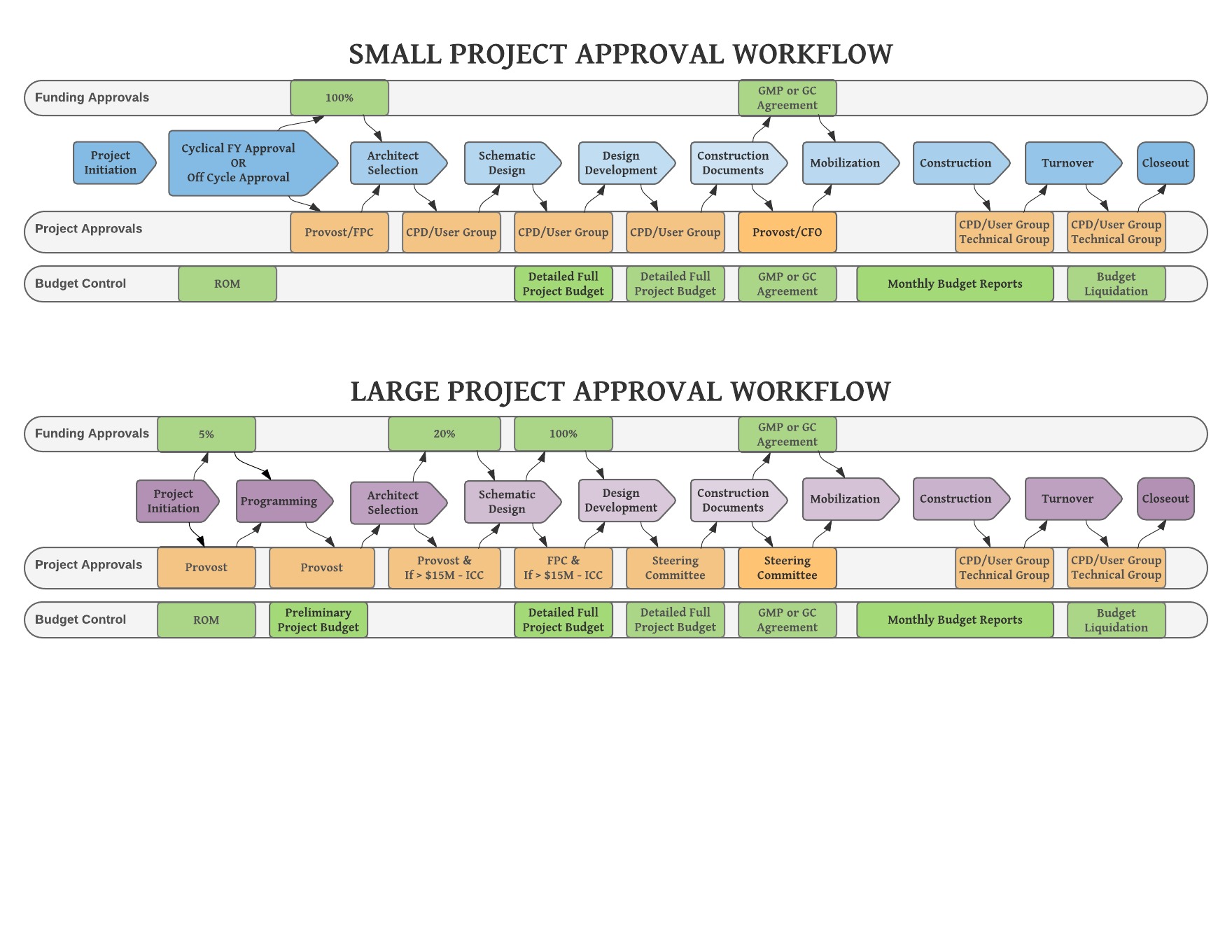As discussed in the Project Governance section, the Guide has established three tiers of projects with different organizational structures. The key difference between the project tiers is that the Board of Trustees (BoT), through its Institutional Capacity Committee (ICC) and Financial Planning Committee (FPC), provides direct oversight of funding for all projects over $3 Million, and has the responsibility to issue design approval to projects greater than $15 Million in value.
Prior to the Trustee review of projects, the Capital Planning Committee (CPC) will review key issues and provide guidance to the project team in order to inform approval presentations to the Board of Trustees. The charter of the CPC indicates that its membership includes the President, Provost, CFO, Vice President for Alumni Relations and Development, and the Vice President for Civic Engagement.
Based on established University protocols, the CPC has the responsibility to review all capital projects. The Capital Planning Committee will be presented with a single large project for individual review, or a group of projects as part of the cyclical Fiscal Year (FY) approval process. Taking into account the CPC’s guidance, the Provost presents the FY Capital A&R projects to the BoT (FPC) for approval. Presentation of large projects to the BoT is the responsibility of the project’s executive sponsor. The workflow and approvals for each project type exhibit significant differences in timing and funding levels:
- Small projects approved to proceed at the end of Project Initiation receive no funding. Small projects that clear the Project Initiation phase are entered into the fiscal year spending approval process, and then approved or rejected as part of a batch on a yearly basis.
- Small projects approved during the Fiscal Year process are immediately funded to 100% of the estimated project cost or at the Budget Office’s discretion, may be funded over multiple fiscal years.
- Some small projects may need to be funded via the Off-Cycle approval process. See below and Process Phases for further explanation.
- Large projects approved to proceed at the end of Project Initiation will have 5% of the estimated total project cost approved and released to the project team in order to proceed to the Programming phase, which typically requires the hiring of external consultants.
- Large projects approved to proceed at the end of Programming will go directly to Architect Selection. If Architect Selection is approved, 20% of the estimated total project cost will be approved and released to the project team in order to proceed to Schematic Design. Large projects will prepare comprehensive project budgets based on the Schematic Design documents and a contractor’s estimate. At this point, funding for 100% of the total project cost is requested in order for the project to proceed to Design Development and ultimately, through the balance of design and construction.
- Although the Trustee governance structure is different for projects over $15 Million, all Large Projects follow the same steps and funding process.
After projects have been funded to the 100% level, the project-level authorities take on full responsibility for oversight of design and budget. There are two distinctions between small and large projects after 100% funding is received:
- For large projects, the Project Steering Committee is responsible for overseeing the design and budget allocations through the design phase. After the design is complete and the GMP or General Contract is executed, CPD and User Groups are responsible for budget oversight through completion.
- For small projects, CPD and the User Groups take on responsibility for project-level budget oversight immediately after 100% funding.
For all projects, the approval process starts during the Project Initiation phase with the initial draft of the Owner’s Project Requirements (OPR). In order to proceed beyond Feasibility, the OPR should be approved by the User Group and CPD. The OPR is then updated and approved at each subsequent milestone throughout the project.
The diagrams below are a graphic representation of the different processes and controls that apply to Small and Large projects. Large projects are funded in increments of 5%, 20%, and 100% during different phases of the project, while small projects are funded 100% through the Fiscal Year or Off Cycle approval processes. Two additional controls apply as well:
- Award of GMP or Lump Sum General Contract at the conclusion of the Construction Documents phase. The approval procedure for this contract will be dictated by existing University procurement and signature authority guidelines.
- During project closeout, Facilities Services will review and reconcile the final project budget. The Budget Office must sign off on the final disposition of remaining project funds in order to formally close out the project budget.
For more detail regarding specific procedures for approvals at each stage of the project, please refer to the Process Phases of the Guide.
